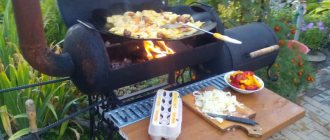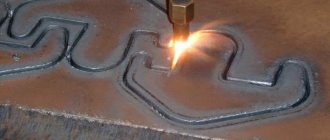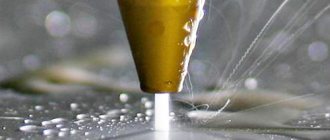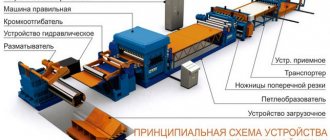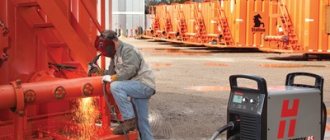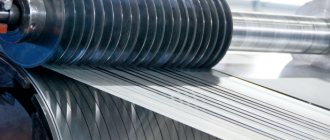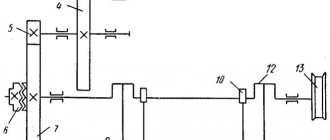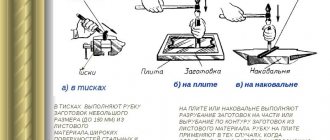Essence of the process
If ordinary water is compressed under a pressure of about 4000 atmospheres and then passed through a hole with a diameter of less than 1 mm, it will flow at a speed 3-4 times higher than the speed of sound. When directed at the workpiece, such a jet of water becomes a cutting tool. With the addition of abrasive particles, its cutting ability increases hundreds of times, and it is capable of cutting almost any material.
Waterjet cutting technology is based on the principle of the erosive (abrasive) effect of an abrasive and a water jet. Their high-speed solid-phase particles act as energy carriers and, hitting the particles of the product, tear off and remove the latter from the cut cavity. The rate of erosion depends on the kinetic energy of the impacting particles, their mass, hardness, shape and angle of impact, as well as on the mechanical properties of the material being processed.
Cutting technology
Water, pumped by a pump to ultra-high pressure of the order of 1000–6000 atmospheres, is supplied to the cutting head. Erupting through a narrow nozzle (nozzle) usually with a diameter of 0.08-0.5 mm at near-sonic or supersonic speeds (up to 900-1200 m/s and above), a stream of water enters the mixing chamber, where it begins to mix with abrasive particles - garnet sand , grains of electrocorundum, silicon carbide or other highly hard material. A mixed jet emerges from a mixing (mixing) tube with an internal diameter of 0.5–1.5 mm and cuts the material. In some cutting head models, the abrasive is fed into a mixing tube. To dampen the residual energy of the jet, a layer of water usually 70–100 centimeters thick is used.
Drawing. Waterjet cutting diagram
Drawing. Abrasive particle mixing scheme
When water cutting (without abrasive), the scheme is simplified: water under pressure escapes through the nozzle and is directed towards the product being cut.
Table. Typical applications of water cutting technologies
| Water cutting | Waterjet cutting |
| Leather, textiles, felt (shoe, leather, textile industry) | Sheets of steel, metals |
| Plastics, rubber products (automotive industry) | Various metal parts (castings, gears, etc.) |
| Electronic boards | Alloys of aluminum, titanium, etc., composite materials, thick-walled plastics (aviation and space industries) |
| Laminated materials (aviation and space industry) | Concrete, reinforced concrete, gypsum blocks, hard paving stones and other building materials |
| Thermal insulation, sealing and noise reduction materials | Stone, granite, marble, etc. |
| Food – frozen foods, dense foods, chocolate, baked goods, etc. | Glass, armored glass, ceramics |
| Paper, cardboard | Combined materials, coated materials |
| Tree | Tree |
| Thermo- and duroplast | Reinforced plastics |
In waterjet cutting, the destructive power of the jet is created to a much greater extent by the abrasive, and water primarily performs a transport function. The size of abrasive particles is selected equal to 10–30% of the diameter of the cutting jet to ensure its effective impact and stable flow. Typically the grain size is 0.15–0.25 mm (150–250 µm), and in some cases it is on the order of 0.075–0.1 mm (75–100 µm) if a low roughness cutting surface is required. It is believed that the optimal abrasive size should be less than the value (dс.т. – dв.с.)/2, where dс.т. – internal diameter of the mixing tube, dv.s. – internal diameter of the water nozzle.
Various materials with a Mohs hardness of 6.5 or more are used as abrasives. Their choice depends on the type and hardness of the workpiece, and it should also be taken into account that a harder abrasive wears out the cutting head components faster.
Table. Typical cutting applications for some abrasives
| Name | Typical Applications |
| Garnet sand (consists of corundum Al2O3, quartz sand SiO2, iron oxide Fe2O3 and other components) | Widely used for cutting various materials, especially high-alloy steels and titanium alloys |
| Electrocorundum grains (consists mainly of Al2O3 corundum, as well as impurities) or its varieties | Man-made materials with very high Mohs hardness. Used for cutting steel, aluminum, titanium, reinforced concrete, granite and other materials |
| Silicon carbide (SiC) grains – green or black | |
| Quartz sand (SiO2) | Glass cutting |
| Silicate slag particles | Cutting plastic reinforced with glass or carbon fibers |
Nozzles are usually made of sapphire, ruby or diamond. The service life of sapphire and ruby nozzles is up to 100–200 hours, diamond nozzles – up to 1000–2000 hours. When water cutting, ruby nozzles are not used, and sapphire nozzles usually last 2 times longer.
Mixing tubes are made of ultra-strong alloys. Service life is usually up to 150–200 hours.
Prices for diamond cutting with thread (rope)
| Thickness of walls and ceilings, mm. | required disk drive | Price of 1 linear meter of diamond cutting with disk systems, rub. | ||
| Monolith Reinforced concrete | Non-reinforced concrete | Brick | |
| 100 | 1,000 rub. | 800 rub. | 600 rub. |
| 150 | 1,500 rub. | 1,200 rub. | 900 rub. |
| 200 | 2,000 rub. | 1,600 rub. | 1,200 rub. |
| 250 | 2,500 rub. | 2,000 rub. | 1,500 rub. |
| 320 | disk Ф800mm is used | 3,200 rub. | RUB 2,560 | RUB 1,920 |
| 370 | disk Ф900mm is used | 3,700 rub. | RUB 2,960 | RUB 2,220 |
| 420 | disk Ф1000mm is used | 4,200 rub. | RUB 3,360 | RUB 2,520 |
| 450 | 4,500 rub. | 3,600 rub. | 2,700 rub. |
| 520 | disk Ф1200mm is used | 5,200 rub. | 4,160 rub. | RUB 3,120 |
| 550 | 5,500 rub. | 4,400 rub. | 3,300 rub. |
| 600 | 6,000 rub. | 4,800 rub. | 3,600 rub. |
| 650 | 6,500 rub. | 5,200 rub. | RUB 3,900 |
| 730 | disk Ф1600mm is used | 7,300 rub. | RUB 5,840 | RUB 4,380 |
Technological parameters
The main technological parameters of the waterjet cutting process are:
- cutting speed;
- type, properties and thickness of the cut product;
- internal diameters of the water nozzle and mixing tube;
- type, size, flow rate and concentration of abrasive particles in the cutting mixture;
- pressure.
Cutting speed (the speed at which the cutting head moves along the surface of the workpiece) significantly affects the quality of the cut. At high speeds, the water-abrasive jet deviates (drifts) from straightness, and the jet weakens noticeably as the material is cut. As a result, the taper of the cut and its roughness increase.
Read also: Kmi 23210 connection diagram
Drawing. Typical cut shape depending on cutting conditions
Drawing. Jet drift when cutting at a speed higher than optimal
Separation cutting can be performed at 80-100% of maximum speed. High-quality cutting usually corresponds to a speed range of 33–65%, fine cutting – 25–33%, and precision cutting – 10–12.5% of the maximum speed.
Photo. Type of cut surface depending on the speed of water-abrasive cutting
Some cutting head models feature automatic taper compensation technology, such as Flow's Dynamic Waterjet. Taper compensation is achieved as a result of a software-controlled dynamic tilt of the cutting head by a certain degree. This allows you to increase cutting speed while maintaining cut quality and, accordingly, reduce production costs.
As the internal diameter of the mixing tube decreases (other things being equal), cutting productivity and accuracy increase, and the cutting width decreases (it is approximately 10% larger than the internal diameter of the tube). This also reduces the service life of the tube. During operation of the mixing tube, its internal diameter increases by approximately 0.01–0.02 mm for every eight hours of operation.
Table. Approximate abrasive sizes for various cutting modes
| Application | Particle size of garnet sand (Garnet) | Int. water nozzle diameter | Int. mixing tube diameter | |||
| mesh (USA) | micron | inches | mm | inches | mm | |
| Standard industrial configuration | 80 | 178 (300–150) | 0,013–0,014″ | 0,330–0,356 | 0,04″ | 1,02 |
| High speed cutting | 60 | 249 (400–200) | 0,014–0,018″ | 0,356–0,457 | 0,05″ | 1,27 |
| 50 | 297 (600–200) | |||||
| Precise cutting | 120 | 125 (200–100) | 0,012–0,013″ | 0,305–0,330 | 0,036″ | 0,91 |
| 80 | 178 (300–150) | |||||
| High precision cutting | 120 | 125 (200–100) | 0,010–0,011″ | 0,254–0,279 | 0,03″ | 0,76 |
The abrasive consumption depends on the diameters of the mixing tube and water nozzle, cutting conditions, etc. The approximate optimal values are given in the table below.
Table. Optimal consumption of abrasive material at certain ratios of the diameters of the mixing tube and nozzle
| Inner diameter of water nozzle (mm) | Mixing tube inner diameter (mm) | Abrasive consumption (g/min) |
| 0,25 | 0,76 | 270–360 |
| 0,36 | 1,02 | 500–640 |
| 0,46 | 1,27 | 800–1100 |
The maximum operating pressure is usually 3000–3200, 3800, 4150 or 6000 bar. The higher the pressure, the higher the cutting speed and efficiency. At the same time, more frequent replacement of gaskets in the pump is required.
Table. Dependence of straight separation (roughing) cutting speed on material thickness at pump pressure P = 4100 bar (approximately 4046 atm)
| Type of material | Cutting speed (m/h) * at thickness | ||||
| 5 mm | 10 mm | 20 mm | 50 mm | 100 mm | |
| Stainless steel | 52,62 | 28,56 | 13,02 | 3,84 | 1,44 |
| Titanium | 68,46 | 37,20 | 16,98 | 4,98 | 1,86 |
| Aluminum | 142,20 | 77,40 | 35,40 | 10,20 | 3,72 |
| Granite | 251,40 | 137,10 | 62,76 | 18,00 | 6,60 |
| Marble | 295,20 | 160,80 | 73,50 | 21,24 | 7,80 |
| Carbon fiber | 247,20 | 134,70 | 61,74 | 17,70 | 6,60 |
| Glass | 272,76 | 148,62 | 67,92 | 19,62 | 7,26 |
| * : pressure – 4100 bar; abrasive brand – Kerfjet #80; abrasive consumption – 250–450 g/min; internal diameter of the nozzle – 0.25 mm, 0.35 mm; internal diameter of the mixing tube - 0.76 mm, 1.01 mm / data from TechnoAllianceGroup LLC, Moscow, BarsJet GAR installations | |||||
Table. Dependence of the speed of straight dividing (roughing) cutting on the thickness of the material at pump pressure P = 6000 bar (about 5922 atm)
| Type of material | Cutting speed (m/h) * at thickness | ||||
| 5 mm | 10 mm | 20 mm | 50 mm | 100 mm | |
| Stainless steel | 86,64 | 47,16 | 21,48 | 6,12 | 2,40 |
| Titanium | 112,38 | 61,50 | 28,08 | 8,22 | 3,06 |
| Aluminum | 233,76 | 127,44 | 58,44 | 16,92 | 6,24 |
| Granite | 413,46 | 225,42 | 103,08 | 29,70 | 10,92 |
| Marble | 485,28 | 264,60 | 121,02 | 34,80 | 12,84 |
| Carbon fiber | 406,56 | 221,88 | 101,40 | 29,22 | 10,86 |
| Glass | 448,14 | 244,38 | 111,72 | 32,16 | 11,88 |
| * : pressure – 6000 bar; abrasive brand – Kerfjet #80; abrasive consumption – 250–450 g/min; internal diameter of the nozzle – 0.25 mm; internal diameter of the mixing tube - 0.76 mm, 1.01 mm / data from TechnoAllianceGroup LLC, Moscow, BarsJet GAR installations | |||||
Photo. Parts obtained by waterjet cutting: made of stainless steel 15 mm thick; made of aluminum alloy 6 mm thick; made of aluminum 30 mm thick; made of fibre-reinforced plastic, 20 mm thick; made of tool steel 60 mm thick
Quarry rope
Recommended cutting speed
- Granite 1 - 2: 25 - 30 m/s
- Granite 3 – 4: 22 – 26 m/s
- Granite 5: 20 - 22 m/s
- Marble: 30 - 35 m/s
Wire saw
- — power minimum: 50 hp
- — linear speed of the rope: 20-30 m/s, V=(3.14*N*Ø)/60 sec, where N is the number of wheel revolutions, Ø is the wheel diameter
- — feed speed: 0.4-0.5 m/h
- — load control parameter: constant reading on the ammeter
How to work?
- — rope tension: constant adjustment based on ammeter readings
- - do not overtighten
- — the tension at the output should be sufficient, the tension at the input should be free, at the start the rope should have a slight slack in case of an increase in the controlled parameter (main motor ammeter)
- - first step: increase water supply
- — second step: reduce the reverse speed. Normal speed is in the range of 40-50 cm/h, low speed is considered less than 40 cm/impact on rope speed
- — in case of high speed, segments may become blurred - you need to reduce the speed
- - in case of low speed, the segments will wear out quickly when cutting on a rainy (wet) day.
- - cover the outer part of the stone on top with plastic film to prevent water from entering holes, holes, cracks
- — the segments can bunch up and the rope can easily get stuck.
How to work with a 50-meter rope?
Cut 10 m from the main loop after 8-10 hours of work (the shorter, the more twist). Replace bushings after 4-5 hours of operation. When connecting, press twice, turning 90°. Inspect the connecting sleeves every 20-30 minutes, change if necessary; quickly finish at the end of cutting (do not use a new rope at the finish); cautions before starting cutting:
- - round the edges
- - inspect the tires on the wheel
- — maximize the radii of rope bends
- — 50 m in operation: 1.5 rpm
- — 40 m in operation: 1.6 rpm
- — 30 m in operation: 1.8 rpm
- — finish: 2 rpm
Procedure for using water when cutting.
- — It is normal to use 3–5 water entry points.
- — The position and quantity should change during the work process.
- — The performance and cutting parameters largely depend on the amount of water.
Problems encountered during the cutting process
A problem that occurs when there is a lack of water.
Incorrectly used rope. This happens when working in forced mode, when the rope is not cooled enough (overheating). As a result, due to the fact that the liquid was supplied at two points, the elastic bands were wiped out and the segments gathered.
Reason for assembling the segments together.
- — Segments are collected at the exit due to stone chipping, they need to be wedged well
- — At the start, due to the fact that the edges are not filed and are quite sharp
- — Using a new rope at the finish (more rigid)
- — Interruptions or stoppage of water supply during operation.
Wear with irregular “V” geometry.
- — Delivery is very fast
- — Lack of water
- — The increase in speed led to the rope rubbing on one side. The ends of the segments are broken
Advantages, disadvantages and comparative characteristics
Using a water-abrasive or water jet, you can cut almost any material. In this case, neither mechanical deformation of the workpiece occurs (since the force of the jet is only 1–100 N), nor its thermal deformation, since the temperature in the cutting zone is about 60–90°C. Thus, compared to heat treatment technologies (oxygen, plasma, laser, etc.), waterjet cutting has the following distinctive advantages:
- higher quality of cut due to minimal thermal effect on the workpiece (no melting, melting or burning of edges);
- the ability to cut heat-sensitive materials (a number of fire and explosive materials, laminated, composite, etc.);
- environmentally friendly process, complete absence of harmful gas emissions;
- explosion and fire safety of the process.
The water-abrasive jet is capable of cutting materials up to 300 mm thick and more. Waterjet cutting can be performed along a complex contour with high accuracy (up to 0.025–0.1 mm), including for processing volumetric products. You can use it to make bevels. It is effective on aluminum alloys, copper and brass, due to their high thermal conductivity, thermal cutting methods require more powerful heating sources. Additionally, these metals are more difficult to cut with lasers due to their low ability to absorb laser light.
Read also: Russian machine for the production of self-tapping screws
The disadvantages of water-abrasive cutting include:
- significantly lower cutting speed of thin steel compared to plasma and laser cutting;
- high cost of equipment and high operating costs (typical for laser cutting) due to the consumption of abrasive, electricity, water, replacement of mixing tubes, water nozzles and seals that can withstand high pressure, as well as waste disposal costs;
- increased noise due to the flow of a jet at supersonic speed (typical for plasma cutting).
Table. Comparison of waterjet cutting with oxygen, plasma and laser cutting
Water cutting is a unique method for processing various materials. Today, there are 2 types of water cutting: using clean water and using a water jet with abrasive (water jet method). But the principle of operation in both cases is the same - liquid under very high pressure passes through a miniature hole in the cutting head, which is located above the material being processed. In this case, the waterjet mixture coming out of the cutting head has a speed exceeding the speed of sound three times.
The size of the head hole, as well as its diameter, depend on the density of the material. If the material is easily permeable, then heads with a diameter of 0.08 mm are taken; in the case of harder materials, the hole diameter can reach 0.8 mm.
As for the pressure of the multiplier itself, the maximum indicator is 420 MPa. According to practical research, the most productive and at the same time fastest cut is obtained at a pressure of 380 MPa. If the pressure is higher, then this only leads to more frequent intervals between replacement parts.
To ensure proper operation of the equipment, gaskets should be replaced promptly. Thus, with a regular constant operating pressure of 400 MPa, the gaskets are replaced after 400 – 1200 cutting hours.
Thanks to such conditions in which workpieces are processed, waterjet cutting becomes an alternative method of influencing materials in relation to thermal methods, and even outperforms the latter in some respects. Only cutting using a water jet with an abrasive leaves no traces of deformation on the metal, no traces of melting on plastic, fabric and other materials. Industrial and design work today is simply unthinkable without this method, because the most complex elements with excellent edge quality can be made from any blanks of varying thickness.
The use of rock destruction technology for extracting minerals under the influence of a water jet has been known since the 30s of the last century, but the industrial use of a high-pressure water jet for cutting various materials began only in the 80s of the same century. Today, waterjet cutting of metal is the most popular type of application of this technology in industrial production.
Features of operating CNC machines
Waterjet equipment with computer program control is one of the opportunities to expand the scope of use of machines, increase work efficiency and at the same time increase productivity.
More details can be gleaned from the information provided below and the video story.
CNC machines are used to produce blanks from steel, aluminum, copper and other types of metals.
The strict cutting accuracy provided by CNC water-abrasive equipment has virtually no deviations from the assigned tasks.
Video:
Program-controlled waterjet units provide the following advantages:
- CNC-equipped machines operate in accordance with a given program. In this case, each workpiece is processed using individual software. With its help, the jet pressure, the composition of the working cutting suspension and other parameters are automatically selected;
- If on non-CNC machines the selection of the cutting jet can be chosen incorrectly, then in this situation this point is excluded. The equipment independently controls the quality of the cut, then automatically adjusts the mode used;
- Metal processing with the help of software also provides the ability to make holes of the desired diameter;
- As you can judge from the video material, upon completion of the waterjet process, a completely finished part emerges from the workpiece, which does not need to be subjected to grinding or additional processing at the cut points.
What is waterjet cutting
Waterjet cutting is a process of abrasive action of a jet of hydraulic fluid with the addition of particularly hard particles on the material being processed to cut it to specified dimensions. From a mechanical point of view, this is the process of separation and entrainment of material by abrasive particles, which are fed at high speed in a stream of water under high pressure. Based on its physical properties, a thin stream of a mixture of water and abrasive at high speed is an ideal cutting tool.
The technology of using water flow and abrasive for cutting almost any materials is ensured by selecting the necessary conditions and parameters, such as:
- jet pressure,
- water consumption,
- the amount of abrasive in the jet,
- sizes of abrasive particles.
The technological capabilities of waterjet cutting are limited only by the thickness of the workpiece being processed and the physical properties of the substance from which it is made. What she can do is clearly shown in this video.
Features of operating CNC machines
Waterjet equipment with computer program control is one of the opportunities to expand the scope of use of machines, increase work efficiency and at the same time increase productivity.
More details can be gleaned from the information provided below and the video story.
CNC machines are used to produce blanks from steel, aluminum, copper and other types of metals.
The strict cutting accuracy provided by CNC water-abrasive equipment has virtually no deviations from the assigned tasks.
Video:
Program-controlled waterjet units provide the following advantages:
- CNC-equipped machines operate in accordance with a given program. In this case, each workpiece is processed using individual software. With its help, the jet pressure, the composition of the working cutting suspension and other parameters are automatically selected;
- If on non-CNC machines the selection of the cutting jet can be chosen incorrectly, then in this situation this point is excluded. The equipment independently controls the quality of the cut, then automatically adjusts the mode used;
- Metal processing with the help of software also provides the ability to make holes of the desired diameter;
- As you can judge from the video material, upon completion of the waterjet process, a completely finished part emerges from the workpiece, which does not need to be subjected to grinding or additional processing at the cut points.
Application area
Waterjet cutting is capable of working with all materials and structures that exist, with the exception of diamonds and tempered glass. One of the features of waterjet technology is the possibility of its use for processing materials capable of changing their physical and chemical properties when exposed to high temperatures and strong heating, as well as for structures with flammable and explosive substances.
The area of industrial use of these features was abrasive cutting of various metals with water under pressure, mainly such as:
- stainless steel,
- tool alloys,
- titanium,
- brass,
- aluminum.
It is also used to make artistic products from natural and artificial stone and use it in processing:
Water cutting is indispensable for:
- insulating,
- fireproof,
- multilayer,
- and other composite materials with special properties.
Input and Output Features
Standard water cutting procedures involve breaking through the surface of the material and cutting along a given path. In some cases, marks may remain on the underside of the product after the jet stops. This feature is also taken into account at the design stage - the input and output locations are often specified. The following options are possible:
- Arc-shaped input and output along a shortened arc - for thin sheet materials.
- Straight input and output – suitable for parts with sharp corners.
- Straight input without direct output - used for cutting thick sheets.
- Straight input and shortened arc output are a combined option for the manufacture of products of complex shapes.
To minimize marks at the bottom of the material, it is recommended to use automatic control systems that allow you to reduce the cutting speed at the end of the procedure.
Advantages and disadvantages
Today, there are four main industrial methods for cutting metals. If we arrange them according to the amount of equipment used and demand in production, we get the following sequence of methods, namely:
- mechanical,
- plasma,
- waterjet,
- laser
All of them differ significantly from each other in quality characteristics, while each has its own characteristics, advantages and disadvantages.
The main advantages of the waterjet processing method are:
- ability to work with any materials,
- no thermal effect on the workpiece,
- eliminating the release of dust, smoke and toxic fumes,
- Possibility to use for materials with explosive and fire hazardous properties.
But despite the undeniable advantages, there are significant disadvantages:
- high cost of replacing wear parts of equipment;
- more significant energy consumption compared to other cutting methods,
- requires constant adjustment and adjustment of equipment to meet the declared characteristics.
Read also: How to find a broken wire in a cable with a multimeter
Control
For efficient operation of the machine, the work of several engineers and operators is required. The designer is required to create the project in a special computer environment. The file is then placed in the device memory. The machine itself distributes functions to other nodes. The employee is responsible for ensuring that there is a sufficient supply of consumables, for launching the program, monitoring its implementation, and providing timely notification of breakdowns. The equipment specialist is required to carry out technical inspection (preventive) and also troubleshoot problems.
CNC waterjet machines
Numerical control allows the most difficult parts to be produced with an error of half a millimeter. The production process is fully automated, it does not require constant commands, it only needs to set the program once (select from a list or enter into memory) and start it. Such equipment is expensive, but more efficient. There is no human factor, that is, the risk of errors is minimized.
How to cut metal by hand with water
Less popular in production, but theoretically possible for production at home. The operator’s task is to select the cutting angle, pressure, pressure and jet width. It is more difficult to work with, but once learned, a specialist will be able to make simple forms very productively. The accuracy remains high, but the feature set is relatively small. Another advantage is that the price is significantly lower than that of CNC equipment.
Industrial Application
The most widely used technology in industrial production and precision engineering is waterjet technology for cutting metal with water. Only it neutralizes the main characteristic consequences that arise when processed by other methods. So, for example:
- waterjet cutting of stainless steel makes it possible to take into account the features that arise when processing workpieces made of metal alloys, such as strength due to alloying additives and high viscosity under mechanical or temperature influences, leading to deformation of finished products;
- waterjet cutting of titanium makes it possible not to reach the critical temperature of 600 ° C, at which titanium is capable of burning in the open air and chemically combining with other substances;
- Waterjet cutting of aluminum reduces the loss of forging material to a minimum, despite the fact that the metal is relatively weak and has a low melting point of only 440 °C.
This treatment makes it possible to use a water cutter for metal with proper efficiency, providing the future product with good quality indicators:
- small seam width - only 0.7-1.4 mm,
- positioning accuracy up to 0.1 mm,
- with a workpiece thickness of even 300 mm,
- obtain a flawless cut edge that does not require additional processing.
The ability to start and carry out cutting in any direction allows you to minimize the overall loss of material when cutting metal blanks.
Possibilities of water-based metal cutting
Many methods are used only for direct sawing, while water cutting allows:
- make a curly cut;
- do not process edges;
- process sheets (metal blanks) up to 120 – 200 mm thick, depending on the type of steel;
- connect a difficult project to an automatic control panel and actually not participate in the process, only control it;
- cut circles, pipes.
Nowadays the technology is actively used in various fields:
- automotive and mechanical engineering in general;
- production of blanks and parts that cannot be stamped;
- water cutting of iron, insulation, fiberglass, insulators, marble;
- artistic processing.
Construction of waterjet cutting equipment
The range of production of waterjet cutting machines starts from small ones, representing conventional CNC metalworking machines and compact ones with a table design for processing sheet material with dimensions of 2 by 4 meters, to huge lines capable of working like rolling mills.
But according to the design principle, any machine for cutting metal with water has:
- body in the form of a water bath, which serves as a trap for the water jet, absorbing its energy,
- a system of settling tanks and filters necessary for water purification, as well as for sedimentation of spent abrasive particles,
- coordinate table with servomotors for moving the cutting head,
- high pressure pump unit with pipelines,
- operator control panel based on an industrial computer.
Modern CNC machines and drives for moving the cutting head allow processing of material using 2D, 2.5D and 3D technology, that is, with high precision, artistic cutting in several planes and processing the edge at any angle. The possibilities of making 3D parts using waterjet cutting are clearly shown in the video.
Scope of application of Diamond threads
Typically, the use of diamonds is facilitated by the lack of deep cutting analogues. When we are no longer talking about ordinary walls or floors, but cutting occurs at really deep distances, about 50 meters. But even in everyday life, you can use cutting with a diamond wire, in places whose thickness does not allow working with diamond saws and drills. For example, during installation and dismantling of reinforced concrete beams or slabs. Cutting such thick structures is simply impossible with simple diamond saws, and experts resort to using diamond thread. Also, for laying ventilation openings along the entire perimeter of the facility under construction. A diamond drill cannot always cope with the length of ventilation shafts.
Cutting tool
The main part of all waterjet machines is the cutting head. The principle of its operation is seemingly very simple, but technologically very complex. Thus, ultra-high water pressure is created by a plunger or piston pump, which delivers it through high-pressure pipelines to the cutting head. Here the water enters the chamber, where strictly dosed mixing with abrasive particles occurs. Next, the mixture of water and abrasive enters a calibrated nozzle (nozzle), which creates a cutting jet. The jet emerging from the nozzle reaches a speed approximately three times higher than the speed of sound.
The dimensions of the diameter of the nozzle and mixing chamber are determined based on the performance of the working pumping station and the material of the abrasive particles. Basically, garnet sand, also called almandine, is used for abrasive. It has a crystalline structure with extreme hardness and a heavy density of 4.1 - 4.3 g/cm, which allows it to provide high abrasive ability. It is well distributed in nature; its largest deposits are located in the southeast of India and Australia.
Water cutting equipment
They call it “dusty-free.” Indeed, there are virtually no chips, or rather, they are immediately washed away, resulting in a very even and clean cut, which, in most cases, does not even require grinding. The technological process is based on a natural phenomenon of water bodies - erosion, that is, the ability to erode the banks, while grinding away stones and tree roots. The essence remains the same, but in order to speed up the effect many times over, an abrasive is added to the liquid.
This mixture is released with a very high pressure jet. The pressure reaches 6 thousand atmospheres, and a speed develops that is three times higher than the propagation of a sound wave in the air - 800-1000 meters per second. Two main tasks of the equipment:
- separation and washing out of particles of workpiece material;
- instant cooling and cleansing.
The device of a machine that cuts with water
The classic device has many components:
- body - usually consists of metal, as the most wear-resistant and durable material, thanks to it, it is quite massive;
- capacity – large, usually at least two cubic liters, but can be more;
- powerful pump - it performs an important function, pumps up high pressure and directs liquid from the reservoir to the junction of the two components;
- durable hoses - connect all components;
- compartment for storing and supplying abrasive particles;
- mixer;
- tool - it regulates the power of the jet, its width, direction;
- the plane on which the workpiece is located and the work will take place;
- Control block.
Most machines are equipped with CNC; the engineer only controls the process using a remote control, but does not do cutting manually. This is convenient - there is no negative impact on the person operating the machine and at the same time excellent accuracy is achieved. Another advantage of CNC is the ability to use computer-aided design programs, which can be used to create a project in a format compatible with the control unit.
Features of the main components
The uniqueness of the installation lies in many differences, starting with the desktop. Instead of the usual plane, a bathtub with shallow sides is presented here. It is equipped with ribs for gripping and fixing the workpiece; they can be quickly removed and applied. Also, the container quickly fills with liquid and then drains. The constant presence of metal in an aquatic environment makes it possible to eliminate noise and dust from production. The container, which contains abrasive particles, is easily removed, has a replenishment function even during operation, and is also equipped with sensors that control the amount of mixture.
Consumables
The main consumable parts of waterjet cutting equipment are nozzles and focusing tubes, which are made from artificial diamonds, sapphires, rubies and corundum crystals.
Thus, the operating time of a focusing tube made of sapphire crystal does not exceed 60 hours. The same tube, made of the highest quality diamonds, lasts much longer, but at the same time costs 20 times more. Artificial ceramic carbide nozzles will last up to 120 hours, which is approximately 20% longer than the same parts made from other materials.
The average operating time of consumables and components is shown in the table:
These figures correspond to the operation of a waterjet machine with an average pressure of 400 MPa. When applying a cutting jet pressure of 600 MPa, the processing speed increases by 20-30%, and wear of the main consumables occurs twice as fast.
Features of the method
To experience all the benefits of wire sawing. Strict adherence to technology is required. For different types of materials, the speed of rotation of the cable is different, the lower the speed, the faster the rope wears out; if the speed is higher than that required for a given rock, the rope can become “soiled,” and in order to start working with this cable again, it must be re-opened, losing a lot of time. and rope resource.
The rope must be twisted.
Often our clients neglect curling or do not take it seriously. But the correct wear of the cable depends on the correct twisting, because if the cable is not worn evenly, you will also lose money later, because the rope will not exhaust its resource to the end.
Insufficient pressure
Often our clients, in order to achieve an increase in the life of the diamond wire, deliberately lower the productivity, but for proper opening of the rope, pressure is necessary. Therefore, at this point you should strictly follow the instructions.
With your own hands
The use of waterjet cutting equipment in a home workshop is quite possible. For example: in the implementation of original works for artistic or decorative processing of small and medium-sized workpieces. But you can make such a machine with your own hands only for cutting wood, plastic, laminate or other not very durable materials.
It should be taken into account that the cost of equipment, plus the periodic replacement of consumables and the constant need for abrasive, makes the direct cost of one working hour of waterjet cutting at least 1,400 rubles. But this is a separate topic, and if you have your own experience in using a waterjet cutter at home, share it with others in the comments block.
Safety precautions
The waterjet cutting process is not particularly dangerous. The distance from the tube from which the jet comes out to the surface being treated is only 2.5 mm. This eliminates the impact of the jet on the hand. When the water pressure exceeds the permissible limit, a relief valve opens, which reduces the pressure to operating pressure. However, certain safety precautions should be observed when working on machines.
- Do not expose your body to the jet under any circumstances. Such a jet is capable of cutting metal 150 mm thick, let alone a hand. While working, keep your hands as far as possible from the cutting area. Before turning on the machine, make sure there are no foreign objects in the cutting path.
- Protect your eyes and hearing. Be sure to wear safety glasses and earplugs (or headphones).
- Do not place your hands on your desk.
